
ClickBlue↑FollowUs!
1. The Concept and Physiological Characteristics of the Eight Extraordinary Meridians
(1) The Concept of the Eight Extraordinary Meridians
The Eight Extraordinary Meridians refer to eight meridians outside of the twelve primary meridians, including the Ren Mai (Ren Meridian), Du Mai (Governing Meridian), Chong Mai (Penetrating Meridian), Dai Mai (Belt Meridian), Yin Qiao Mai (Yin Heel Meridian), Yang Qiao Mai (Yang Heel Meridian), Yin Wei Mai (Yin Linking Meridian), and Yang Wei Mai (Yang Linking Meridian). The term “extraordinary” (qi) indicates their distinct nature. Because they differ from the twelve primary meridians, they are called “extraordinary meridians.” They do not directly connect to the organs and do not have a paired relationship. Their physiological function mainly involves the storage and regulation of Qi and blood flow in the twelve primary meridians.
(2) Physiological Characteristics of the Eight Extraordinary Meridians
The physiological characteristics of the Eight Extraordinary Meridians are threefold: 1) The Eight Extraordinary Meridians have no direct connection to the organs. 2) There is no paired relationship among the Eight Extraordinary Meridians. 3) The distribution of the Eight Extraordinary Meridians is not as widespread as that of the twelve primary meridians; there are no distributions of the Eight Extraordinary Meridians in the upper limbs.
Their pathways also differ from those of the twelve primary meridians; except for the Dai Mai, the others generally run from the lower body upwards.
The common physiological functions of the Eight Extraordinary Meridians are:
1. Further strengthening the connections between the twelve primary meridians: For example, the Du Mai governs all Yang meridians; the Ren Mai connects all Yin meridians; the Dai Mai restrains the longitudinal meridians. The two Qiao meridians govern the Yin and Yang of the body; the two Wei meridians link the Yin and Yang of the interior and exterior. Thus, the Eight Extraordinary Meridians further enhance the connections among various parts of the body.
2. Regulating the Qi and blood of the twelve primary meridians: When the Qi of the twelve primary meridians is abundant, it is stored in the Eight Extraordinary Meridians; when the Qi and blood of the twelve primary meridians are insufficient, the Eight Extraordinary Meridians “overflow” to provide timely supplementation.
3. The Eight Extraordinary Meridians have a close relationship with the liver, kidneys, and other organs, as well as with the uterus, brain, and marrow, indicating a significant connection in both physiological and pathological contexts.
2. The Pathways and Physiological Functions of the Eight Extraordinary Meridians
(1) The Pathway and Physiological Function of the Du Mai
1. Pathway: The Du Mai originates in the lower abdomen, exits at the perineum, travels posteriorly to the Changqiang (Long Strong) point at the sacrococcygeal region, ascends along the spine, passes through the nape to the Fengfu (Wind Palace) point, enters the brain, connects to the brain, follows the midline of the head, ascends to the Baihui (Hundred Meetings) point at the crown, descends through the forehead to the Suliao (Clear Communication) point at the tip of the nose, passes through the philtrum, and reaches the Gingjiao (Gum Intersection) point at the center of the upper gums.
2. Branches: The first branch, originating with the Chong and Ren meridians from the uterus, exits at the perineum, and at the coccyx, it connects with the Foot Shaoyin Kidney Meridian and the Foot Taiyang Bladder Meridian, penetrating the spine and connecting to the kidneys. The second branch ascends directly from the lower abdomen through the navel, travels upward to the heart, meets the Chong and Ren meridians at the throat, and encircles the lower jaw, reaching the center below the eyes. The third branch, originating from the inner canthus of the Foot Taiyang Meridian, ascends to the forehead, meets at the crown, connects to the brain, then branches down the nape, along the inner scapula, and both sides of the spine, reaching the waist and entering the muscles on either side of the spine, connecting to the kidneys.
3. Physiological Functions
(1) Regulates the Qi and blood of the Yang meridians, serving as the “sea of Yang meridians”: The Du Mai runs along the back, which is Yang, indicating its role in commanding and supervising the Qi of all Yang meridians. Additionally, the six Yang meridians all intersect at the Dazhui (Great Vertebra) point, demonstrating the Du Mai’s regulatory function over the Yang meridians, hence the saying “governs all Yang meridians of the body.”
(2) Reflects the functions of the brain, kidneys, and spinal cord: The Du Mai belongs to the brain and connects to the kidneys. The kidneys produce marrow, and the brain is the sea of marrow. The relationship between the Du Mai and the brain, kidneys, and spinal cord is very close.
(3) Governs reproductive functions: The Du Mai connects to the kidneys, which are associated with reproductive functions, thus linking the Du Mai to reproductive health.
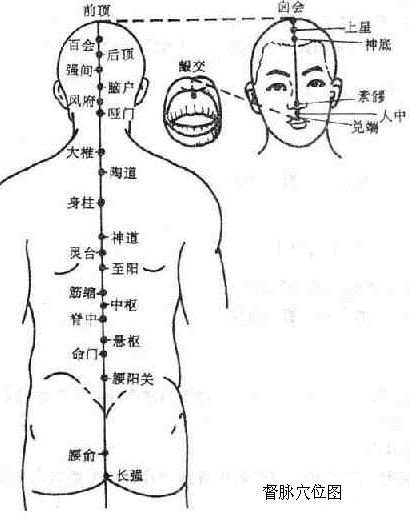
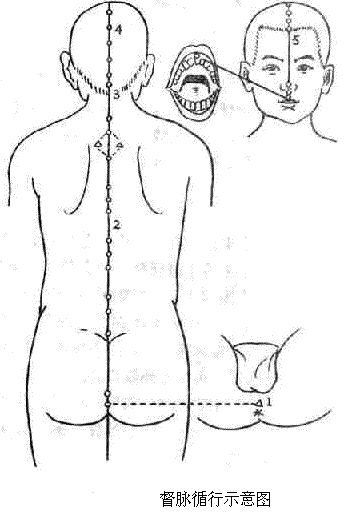
(2) The Pathway and Physiological Function of the Ren Mai
1. Pathway: The Ren Mai originates in the uterus, exits at the perineum, travels through the Yinfu (Yin Mound), ascends along the midline of the abdomen, passes through the throat (Tiantu point), reaches the inner lower lip, divides left and right, encircles the lips, intersects at the Gingjiao point of the Du Mai, and then passes through the sides of the nostrils, ascending to the lower eye socket (Chengqi point), where it intersects with the Foot Yangming Meridian.
2. Branches: It penetrates the spine from the uterus, ascending along the back.
3. Physiological Functions
(1) Regulates the Qi and blood of the Yin meridians, serving as the “sea of Yin meridians”: The Ren Mai runs along the midline of the abdomen, which is Yin, indicating its role in overseeing and managing the Qi of all Yin meridians. Additionally, the three Yin meridians of the foot intersect with the Ren Mai in the lower abdomen, and the three Yin meridians of the hand connect to the Ren Mai through the three Yin meridians of the foot, thus the Ren Mai has a regulatory effect on the Qi and blood of the Yin meridians, hence the saying “governs all Yin meridians.”
(2) Regulates menstruation and supports fetal development: The Ren Mai originates in the uterus, playing a role in regulating menstruation and promoting female reproductive functions, hence the saying “the Ren governs the uterus and fetus.”
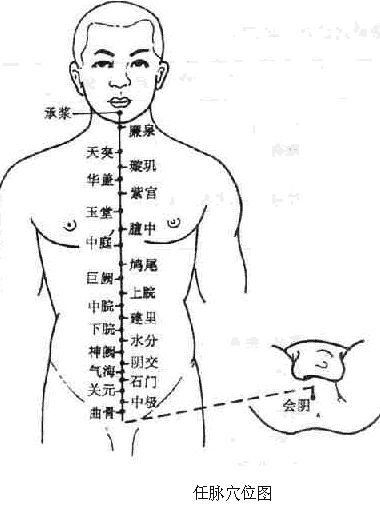
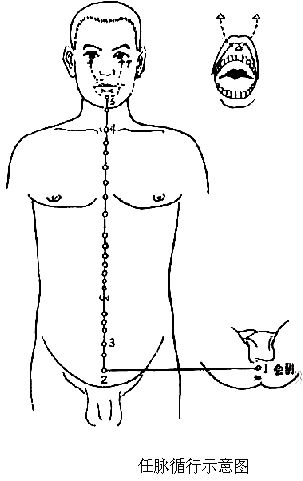
(3) The Pathway and Physiological Function of the Chong Mai
1. Pathway: The Chong Mai originates in the uterus, exits at the perineum, and divides into two branches. The ascending branch (the main trunk of the Chong Mai) runs along the anterior abdominal wall, near the navel (five fen from the navel), parallels the Foot Shaoyin Meridian, spreads in the chest, ascends through the throat, and encircles the lips; the descending branch runs along the posterior abdominal wall, ascending within the spine. The descending branch exits at the perineum, travels down the inner thigh to the space between the big toe.
2. Physiological Functions
(1) Regulates the Qi and blood of the twelve meridians: The Chong Mai ascends to the head and descends to the feet, traversing the entire body, serving as a crucial conduit for the Qi and blood of all meridians. When the Qi and blood of the meridians and organs are abundant, the Chong Mai can store and reserve it; when they are insufficient, the Chong Mai can provide infusion and supplementation to maintain the normal physiological activities of the body’s tissues and organs. Thus, it is referred to as the “sea of the twelve meridians,” the “sea of the five organs and six bowels,” and the “sea of blood.”
(2) Governs reproductive functions: The Chong Mai originates in the uterus, also known as the “blood chamber” or “blood sea.” The Chong Mai plays a role in regulating menstruation. It is closely related to reproductive functions; for women, “when the Chong Mai is abundant, menstruation occurs regularly, leading to conception.” Conversely, if the Chong Mai is deficient, it can lead to reproductive dysfunction.
(3) Regulates the ascending and descending of Qi: The Chong Mai, in its pathway, connects with the Foot Shaoyin, belongs to the Yangming, and communicates with the Jueyin and Taiyang. The Chong Mai has the function of regulating the ascending and descending of Qi in certain organs (mainly the liver, kidneys, and stomach).

(4) The Pathway and Physiological Function of the Dai Mai
1. Pathway: The Dai Mai originates at the lateral costal region, descends obliquely, intersects at the Dai Mai point of the Foot Shaoyang Gallbladder Meridian, encircles the body, and at the Dai Mai point, it descends obliquely along the upper edge of the hip bone to the lower abdomen.
2. Physiological Functions: It restrains the longitudinal meridians and governs the discharge of women.
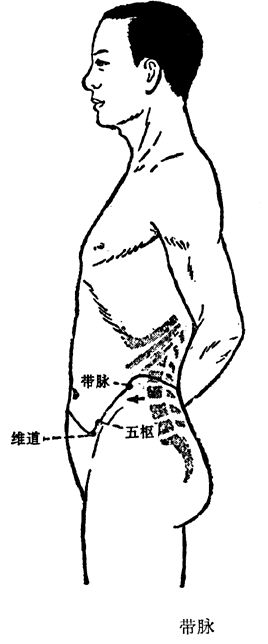
(5) The Pathway and Physiological Function of the Yin Qiao Mai
1. Pathway: The Yin Qiao Mai originates at the inner side of the heel from the Foot Shaoyin Meridian’s Zhaohai point, ascends through the inner ankle, along the inner side of the thigh, enters the anterior genital area, ascends along the anterior surface of the trunk to the chest, enters the Qiaoyin point at the throat, and reaches the side of the nose, connecting to the inner canthus, and ascends along with the Foot Taiyang and Yang Qiao Mai.
2. Physiological Functions: It controls the opening and closing of the eyes and the movement of the muscles.

(6) The Pathway and Physiological Function of the Yang Qiao Mai
1. Pathway: The Yang Qiao Mai originates at the outer side of the heel from the Foot Taiyang Meridian’s Shenmai point, ascends along the posterior side of the outer ankle, travels up the outer side of the lower limb to the abdomen, along the posterior outer side of the chest, from the back of the armpit to the shoulder, ascends along the neck, and reaches the inner canthus of the eye. It connects with the Foot Taiyang Meridian and the Yin Qiao Mai, then ascends along the Foot Taiyang Meridian to meet the Foot Shaoyang Meridian at the Fengchi point behind the neck.
2. Physiological Functions: It controls the opening and closing of the eyes and the movement of the muscles.

(7) The Pathway and Physiological Function of the Yin Wei Mai
1. Pathway: The Yin Wei Mai originates at the Zhuyin point, five cun above the inner ankle of the Foot Shaoyin Meridian, ascends along the posterior inner side of the lower limb, reaches the abdomen, travels alongside the Foot Taiyin Spleen Meridian to the lateral costal region, intersects with the Foot Jueyin Liver Meridian, ascends to the Tiantu point of the Ren Mai, and terminates at the Lianquan point in the throat.
2. Physiological Functions: The “Wei” in Wei Mai means to connect and link. The Yin Wei Mai serves to connect the Yin meridians.
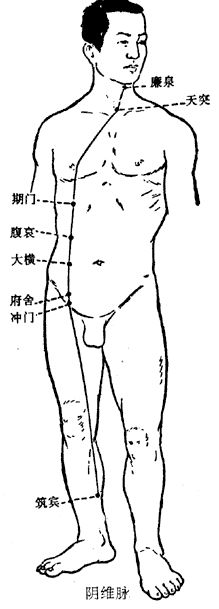
(8) The Pathway and Physiological Function of the Yang Wei Mai
1. Pathway: The Yang Wei Mai originates at the Jinmen point of the Foot Taiyang Meridian, passes over the outer ankle, ascends along the outer side of the lower limb, travels along the posterior outer side of the trunk, from the back of the armpit to the shoulder, ascends along the neck, and reaches the forehead, distributing over the side of the head and the back of the neck, connecting with the Du Mai.
2. Physiological Functions: It connects the Yang meridians.

1
Next Issue Preview
Next Issue Preview
● Physiological Functions of the Meridians: The meridians interconnect and traverse throughout the body, linking the internal and external aspects, organs, limbs, and orifices into an organic whole, playing a crucial role in the physiological functions of the body. The fundamental substance that constitutes the meridian system and maintains its functional activities is called meridian Qi, which runs within the meridians, hence also referred to as pulse Qi. Meridian Qi is a part of the body’s true Qi, representing a life substance that manifests as the movement function of the meridians and the overall life functions of the body. Qi is formless while blood is substantial; Qi is Yang while blood is Yin, and the two maintain each other. Qi cannot harmonize without blood, and blood cannot move without Qi. Therefore, the entire body is traversed by Qi and blood. The Qi running through the meridians actually includes all life-sustaining nutrients necessary for life, such as Qi, blood, essence, and body fluids, collectively referred to as Qi and blood. Thus, the meridians are the pathways for the movement of Qi and blood.
1. Connection; 2. Induction; 3. Nourishment; 4. Regulation
● Applications of Meridian Theory
1. Explaining pathological changes
2. Diagnosis of diseases
3. Treatment of diseases
This article is sourced from the internet; if there is any infringement, please contact for removal!
Your likes are our motivation for progress!
↘↘↘

